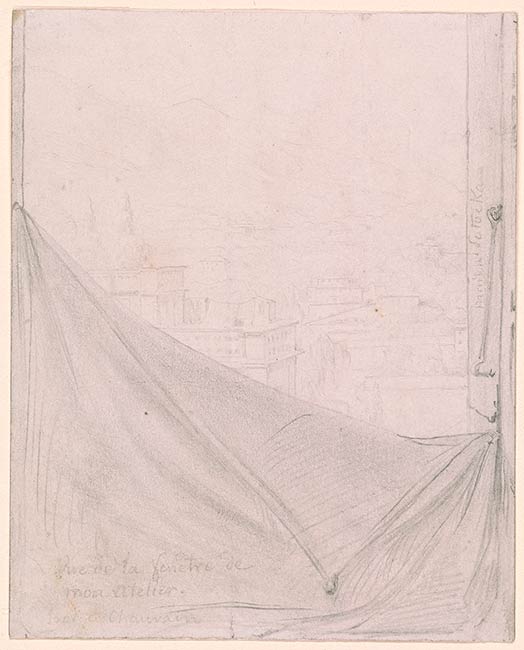

After a successful career painting easel pictures and decorative cycles, Delaroche traveled to Italy for a year in 1844-45 and emerged with a stronger commitment to religious subjects and a heightened interest in portraiture. With the death of his wife, Louise, in 1845, the artist was distraught, and the revolutionary activities of 1848 further unsettled him. Delaroche spent much of the year and the following two outside Paris, staying at La Havre, Aix-la-Chappelle, and in Nice.
This pencil sketch shows the view, half hidden by a window covering, from Delaroche's studio at the Hotel Chauvain in Nice. He has labeled and drawn an arrow to the Villa Potocka visible in the distance (now part of the Institution Stanislas). Delaroche stayed at the hotel in 1849 just before he settled into a villa he had purchased next to that of the fashionable Delfina Komar (1807-1877), Comtesse Potocka of Poland. Potocka fled an unhappy marriage and settled in Paris in the 1830s, traveling to Nice and Naples, where her family owned villas. The expatriate countess was a patron of the arts, a friend of musician Frederic Chopin (who enjoyed her singing), and the Polish poet Zygmunt Krasinski. Delfine and her sister Ludmila (1819-1881) were part of the artist's social circle in Nice, and he painted portraits of them around 1849-50. A second drawing in the Morgan that was executed in Nice and remained with this sheet depicts a design for a tomb (1995.18).
Inscribed by the artist at lower left, "vue de la fenêtre de mon atelier / hotel Chauvain" and at center right, along the edge of the sheet, "Maison Potocka" (with an arrow).
McIntosh, DeCourcy E., former owner.
